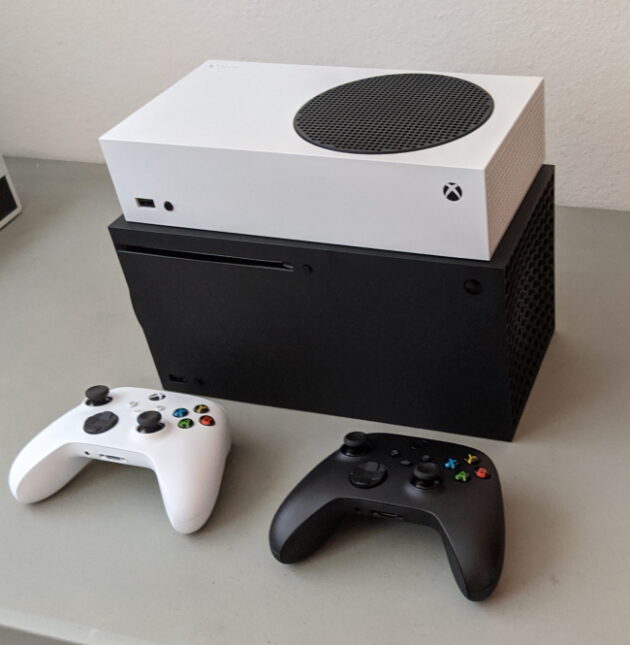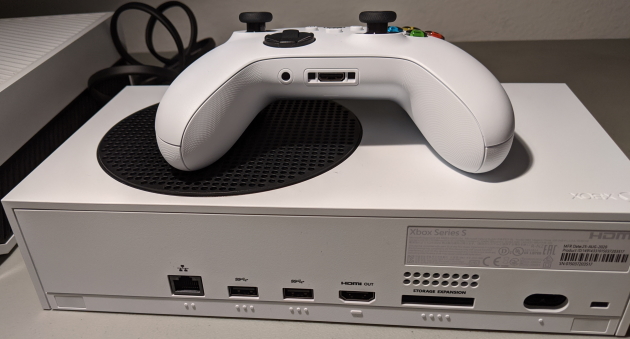
The first thing I saw when I opened the boxes for the Xbox Series X and S was a command. Each unit came shipped with a cardboard sleeve wrapped around it that read: Power Your Dreams. Apparently Microsoft felt like we all needed a bit of inspiration this year.
That sleeve, however, is one of surprisingly few items in the box. The newest Xbox, whether it’s Series X or S, is a minimalist piece of gear. Sure, it looks like one in the early press photos and mock-ups, but I didn’t appreciate the degree thereof until I had one in my hands.
The Series X is a heavy, matte-black brick, while its little brother the digital-only Series S is a lightweight white rectangle made to resemble the Xbox Adaptive Controller. Both have ventilation openings on the sides that make the unit look a bit like a particularly chunky Bluetooth speaker, but they’re otherwise mostly featureless.
The Series X and S are all function, no style, even by comparison to most standard models of the similarly low-key Xbox One. The Series X in particular, if not for the Xbox logo on its corner that lights up when it’s running, could be mistaken for a subwoofer, while the Series S looks more like a big network switch than a gaming console circa 2020.

The other contents of each console package only differ in terms of the actual unit inside. When you buy a new Xbox in the Series line, you also get one of the new Xbox wireless controllers, colored to match the console; an HDMI cord; a power cord, which doesn’t feature one of the massive power “bricks” that were a hallmark of both the 360 and One; a small booklet of safety guidelines; and a small one-sheet cardboard insert with setup information for the system.
For the Series X and S, most of the first-time setup can be done with a mobile app, rather than a series of menus that you fill out on start-up, and the Series X/S “manual” is just a set of instructions that point you toward the app.
I do want to mention the packaging. When I opened up new consoles in previous generations, I usually ended up with a pile of styrofoam, cellophane, twist-ties, and other assorted junk, much of which can’t be recycled. The Series X/S, by comparison, is packed tight in corrugated cardboard, with a few small plastic ties around the cords and a couple of recyclable foam sheets surrounding the controller and console. It’s a solid step forward for the unit’s overall environmental impact, similar to Valve’s all-recyclable box for its Index VR set from earlier this year.
Both Series models of Xbox feature a similar arrangement of ports. On the front, both have a single USB port for whatever backup drives or wired controllers you opt to use, including legacy models from your Xbox One. On the back, both feature two USB slots, an HDMI-out, a port for Microsoft’s $219 storage expansion cards, and an Ethernet port. (It is a bit of a relief that the all-digital Series S won’t also be WiFi only.) All of the slots sit flat against the unit, without the surrounding recesses from previous models of Xbox.
An interesting extra for the Series X, which hasn’t been heavily advertised as far as I can tell, is the presence of a Kensington Security Slot on the back. Some models of the Xbox One also reportedly had this feature, but it wasn’t at all common, to the point where I didn’t know it was an option before now. The Kensington slot lets you use a compatible cable to attach your Series X to something else in order to protect it against theft, in much the same way that you’d use a bike lock. If you’re planning to take your Xbox with you into a shared environment, like a demo station or a college dorm (whenever those open again, anyway), the K-slot on the Series X makes a decent argument for spending the extra money over the Series S.


The word I keep coming back to here is “functionality.” Compare the Series X or S to its primary competitors: the Nintendo Switch is largely built around its screen, and can’t be mistaken for anything else, while the PlayStation 5 looks like a glowing art-deco humidifier and is made to catch the eye. Both companies have gone well out of their way to make sure their consoles’ looks are part and parcel of the brands they’re building.
Then there are the new Xboxes, which are seemingly meant to blend seamlessly into the rest of your entertainment center. It’s an interesting visual representation of Microsoft’s recent overall strategy, where the physical Xbox is just a method of entry into their gaming “ecosystem,” and as such, isn’t treated like it’s the most crucial part of the overall experience. There’s a lot going on under the surface, but 19 years into the Xbox line, this might be the lowest-key look that they’ve ever sported.



